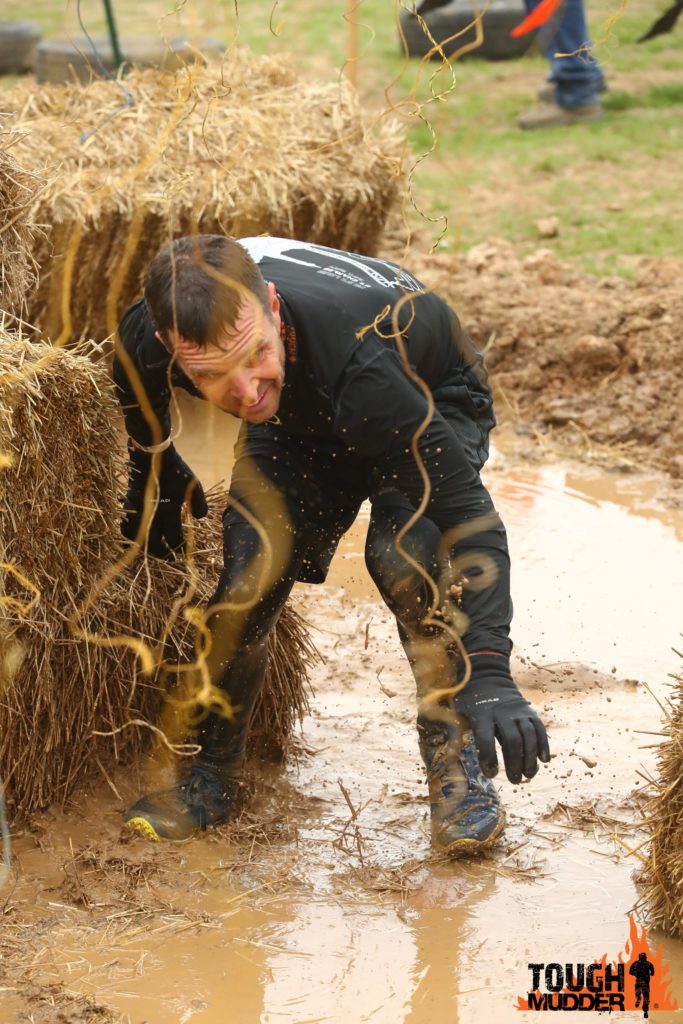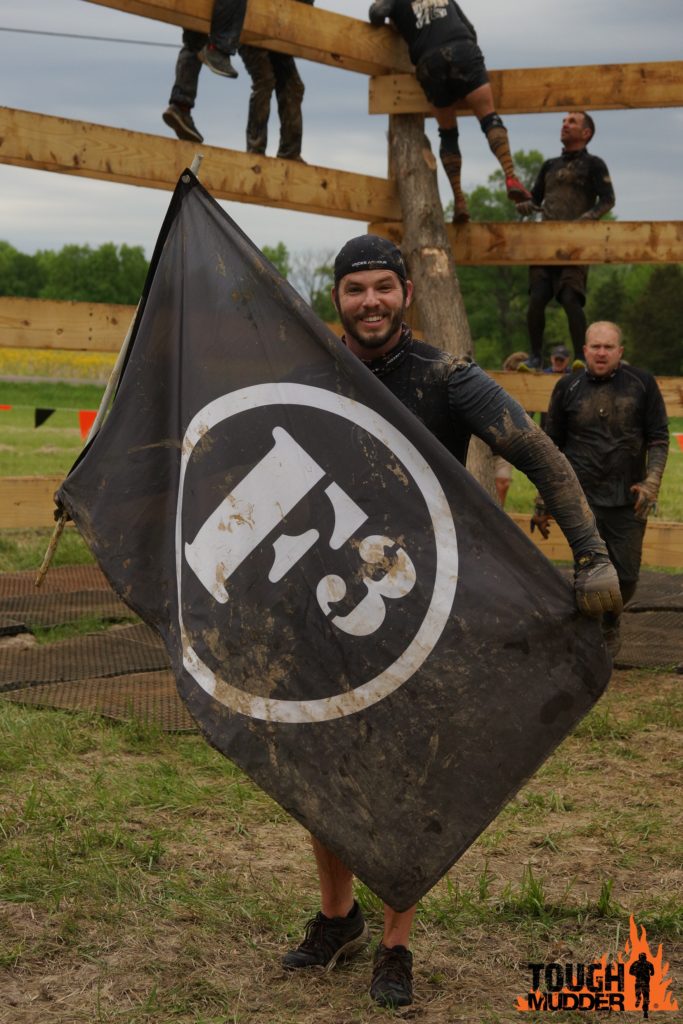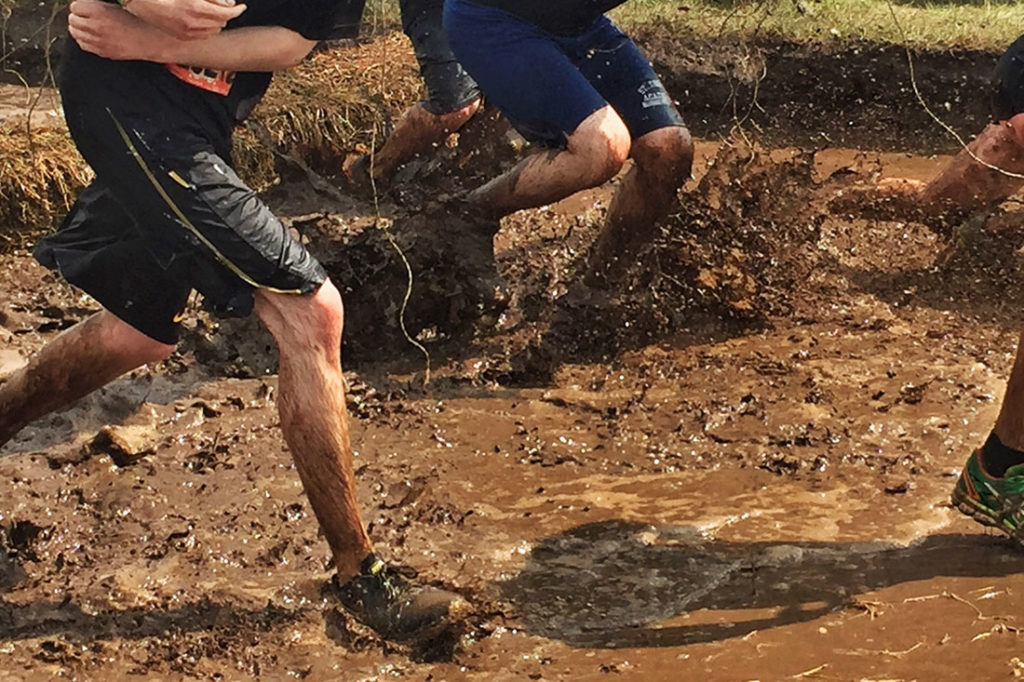I was shivering long before I jumped into the ice bath. As I dunked my head under water, the cold hit me like a lightning bolt and exploded inside me. My soft, rolling shivers turned sharp and severe. I climbed out of the bath—known on the Tough Mudder obstacle course as Arctic Enema—put my feet on the trail and ran at a steady clip, hoping against hope that moving my body would warm it.
I should have known better. I was 8 miles into the 10-mile, 25-obstacle event, and I had been shaking with cold for most of it. Running gave me only marginal (and short-lived) relief before I had to either get in water again or slow for an obstacle or stop to catch my breath.
After leaving Arctic Enema, I ran 100 yards and turned a corner, another 100, 200, 300, then something strange happened. I wasn’t so cold anymore. My whole body pulsed like the flash of a distant explosion. A split-second later, the noise reached me and my eyes bulged, my pace quickened, and I wanted to do cartwheels, back handsprings, dance. I felt alive, electric, joyful.
Maybe it was an adrenaline dump, or my body revolting against the cold, or perhaps this was just a physical manifestation of the fact I was happy not to be dead. Whatever the case, the sensation lasted a minute or so, then I started shaking again.
I signed up for the Tough Mudder because I wanted to write about overcoming obstacles. But the unrelenting cold meant I didn’t overcome anything. The best I can say is that I finished, persevered to the end and lived to tell the tale of these three lessons, albeit through chattering teeth.

1. Some obstacles can only be endured, not overcome.
In the weeks before the event, I ran far more than I usually do to be ready to cover the 10-mile course. I worked on grip strength and upper body strength and solidified my core. It’s hard to say any of that helped. The cold was an obstacle I did not prepare for.
The worst part was there was no way to get warm without quitting, and I wasn’t going to quit. As the day wore on, I began to think of the cold as like the downturn in the media industry—the biggest obstacle I’ve faced in my career. It was simply a fact of life. There was no way to overcome it, no way to conquer it, I just had to deal with it as best I could.
I learned that at an obstacle called Rope-A-Dope. A series of ropes hung down halfway across a pool that was 15 feet wide, 45 feet wide and 5 feet deep. I jumped, grabbed one of the ropes, and pulled myself up it to a height of 15 feet. From there, I wrapped my hands around a pole that stood at an angle down to the ground on the other side of the pool. I needed to kick my legs up, tuck them over the pole, then shimmy down it.
But my abs and legs were fried. I couldn’t get my feet over the pole. I tried to go hand over hand, with my feet dangling below me, down the pole instead. I made it a few inches before my hands gave out, I let go and splashed into the water.
On a warm day, I’m pretty sure I would have made it. With quivering fingers I struggled to open and close and muscles fatigued from shaking, I didn’t stand a chance.
I wasn’t alone. After I climbed out of the Rope-A-Dope pool, I watched athlete after athlete fall just as I had. The saving grace amid the cold and failure—the reason I kept going—was that everybody else was cold and failing, too. We were in it together.
2. Leave nobody behind.
We all became solopreneurs because we want to thrive on our own merits. But I learned as a freelancer, and I hope you do, too, that I can only make it so far on your own. I have to be willing to receive help. Just as important, I have to be willing to give it.
I saw that over and over again on the Tough Mudder course. That ethos is baked into the event. Even the t-shirts say it is not a race, it’s a challenge. It wasn’t just friends helping friends. It was strangers helping strangers. If I wasn’t pulling someone out of a mud pit, someone was pulling me out of one. I pushed people up from below by their feet, their thighs, their backs. I haven’t had so many strangers’ hands on me since the last time I crowd-surfed.
I learned about the power of being there to hold someone up as I ran alongside my friend Caleb “Heisenberg” Baldwin. He joined our 12-man team the night before, a last-minute replacement for someone who had to bow out with an injury. Heisenberg is part of the workout group from which we formed our Tough Mudder team, but he initially resisted joining us because he has wrestled his whole life with a fear of mud.
He decided to join us when he imagined himself waving goodbye to us as we drove to the event, which gave him “a mental picture of myself that I couldn’t stand to look at.” He instead opted to “run into the maw of my own fear monster.” I watched as he did that, time after time.
A Tough Mudder photographer snagged a great picture of Heisenberg, smiling broadly, holding our team flag, his body caked with mud. It wasn’t being muddy that bothered him, it was being in the mud. The possibility of getting stuck freaks him out. Note the present tense. It never got easier. Every time we approached an obstacle—there were 25 of them—he studied it as we got near to determine whether it involved mud. When it did, he dug inside himself to be able to dive in.

He drew power from watching others conquer their own obstacles—be it pain or fear of heights or whatever. “I’m still really unsettled by the idea of messing around in mud. When crossing creeks, I will still find the driest, cleanest path,” he said. “But when faced with hard challenges, things that do seem insurmountable, I know that I won’t back down because my brothers on my left and on my right are going to be there with me.”
3. Delayed gratification is still gratification.
Full disclosure: 9 miles of helping other people, and letting them help me, was enough. With 1 mile left, I stopped caring how others were doing and hurried through the last few obstacles, including one called Electroshock Therapy, in which hundreds of yellow cords surging with 10,000 volts of electricity crowded the way forward like a series of evil bead curtains. I somehow made it through without getting shocked. One of my friends was “mad” at me for slithering through unscathed; he was right behind me and got popped big time.
The finish line was a few feet past Electroshock Therapy. On any other day, I would have waited for my friends and crossed the line with them, arm in arm. But I could bear the cold no longer. Plus, I wanted to get checked out at the medical tent because at mile 6, I got hit in the forehead with a log. I almost didn’t mention this because it sounds worse than it was, which I would describe as “bad enough that I wanted the medical team to look at it but not so bad I quit the event.” I had a trickle of blood in the center of my forehead, but the cut was so small the doctor asked if I wanted a Band-Aid as opposed to just giving me one.
The cut still shone on my forehead several days later. I wore it with pride. At church, at restaurants, every time I left the house, I felt like a vain Harry Potter arriving at Hogwarts. Go ahead, ask about my scar, I don’t mind… you can see the scar right? Aren’t you curious to hear how I got it? Maybe I’ll just voluntarily tell you because you’re too embarrassed to ask.
Anyway. After 10 miles, 25 obstacles, three hours of shivering and a minor head injury, crossing the finish line provided no satisfaction. I did not raise my arms in triumph. I did not celebrate. I didn’t get a picture. Hell, I didn’t even smile.
But a few hours later, with dry clothes on me, hot coffee in me and a giant burger in front of me, I laughed through lunch as we rehashed our impossibly miserable morning. It was so terrible none of us can wait to do it again. For days we shared joyful texts that pondered the strange places our bodies hurt, wondered how we got that bruise and joked about finally getting our core temperatures back to normal.
I’m definitely doing Tough Mudder again. There’s a Rope-A-Dope waiting to be conquered, and I will conquer it.
As long as it’s warm that day.
Photos courtesy of Matt Crossman; featured image by @tori_aper/Twenty20



